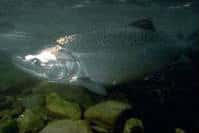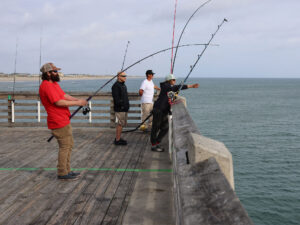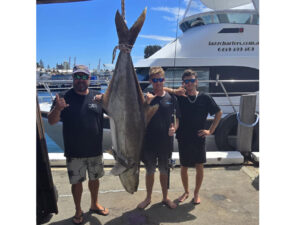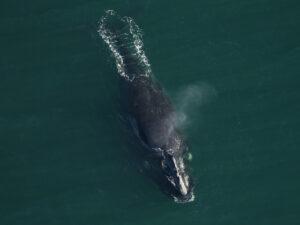
King Salmon Returning to Spawn
No one seems happy with California’s plan to help spawning and juvenile king salmon in the San Joaquin River and its tributaries, according to a report in the Merced Sun-Star. According the story, politicians, farmers and irrigation district officials gathered in Sacramento for a public hearing on Wednesday (March 20, 2013) to decry the economic impacts of the state’s proposed plan. At the same time, environmental regulators joined the commercial-fishing industry in criticizing the plan for not going nearly far enough, the report said.
The Sun-Star reported that the Bay-Delta Water Quality Control Plan, in its draft form, would require regional irrigation districts to leave 35 percent of mountain runoff in the Merced, Tuolumne and Stanislaus rivers from February to June. But the Calfornia State Water Board claims that the decrease in available water for agriculture would result in the loss of hundreds of jobs and tens of millions of dollars in annual economic activity.
Assemblyman Adam Gray, D-Merced, and others from the region spoke against the plan during the meeting, held at the Environmental Protection Agency, said the report. “Taking more water from three rivers so vitality important to our well being is like asking someone on unemployment for a loan,” Gray said. Merced farmer Joe Scotto said the plan will greatly impact his livelihood. “If the board makes a decision that includes the 35 percent, my life’s work will turn to dust,” Scotto said.
However, salmon advocates said the state’s economic analysis was incomplete, calling on the board to prioritize the impacts to the commercial-fishing industry, the Sun-Star reported. “Our Central Valley fish make up the majority of the fish that are caught,” said Roger Thomas, president of the Golden Gate Fishermen’s Association. “You can see what happened when the runs went down. Salmon is a great resource. It saves all the coastal communities.”
Six years ago, California’s king salmon populations plummeted so low that fisheries managers, in a desperate attempt to avert extinction of the strain, shut down all fishing in two consecutive years – 2008 and 2009 – and condensed the 2010 season to just 10 days.
Fortunately, in 2011 and 2012, the salmon came back with a vengeance, as both recreational and commercial fishermen enjoyed successful ocean fishing off the Northern California coast. For the 2013 season, which will open April 6, fishery managers predict that ocean populations of king salmon off Northern California will be strong again.
Yet, questions and controversy still swirl around the California salmon fishery collapse. Scientists have attributed the decline to many factors ranging from warming ocean waters to degradation of spawning habitat caused by agricultural runoff. Hydroelectric dams along tributaries that salmon follow to find spawning grounds have also had an impact, but long-standing state hatchery programs have more than mitigated this loss of naturally reproducing fish.
One factor, however, looms more largely than any other, according to Victor Gonella, president of the Golden Gate Salmon Association. Gonella points to increasing water diversion from the Sacramento-San Joaquin Delta, mostly for agricultural uses in California’s vast semi-arid Central Valley, though some also goes to supplies cities in Southern California.
“This involves massive pumping operations that cause major problems for salmon,” he explains. “This removes the very water that juvenile salmon need to survive, but also sucks in and kills countless juvenile salmon that never make it to sea. Unless we address this issue and do so immediately, we are headed for another collapse.”
In yesterday’s meeting, agriculture supporters repeatedly argued the proposed new flow requirements would likely do little to increase salmon populations, the Sun-Star reported. “This proposal takes water at a time when it is most valuable and sends it down river with only a hope that it will benefit the fish population,” said state Sen. Anthony Cannella. “Water is too valuable to waste on the hope that it will make a difference.”
The report said that federal and state environmental regulators agreed that the proposal would do little to improve fish populations, especially in average and dry years. “We have a fishery that’s on the edge,” said John Shelton, environmental scientist with the California Department of Fish and Wildlife. “We recommend strongly that you protect it in the low-flow years. Otherwise, it will be wiped out.”
The plan allows the board to annually adjust the flow requirement between 25 and 45 percent of spring-time runoff, depending the health of the fisheries and other factors. Environmental regulators said long-term gains in fish populations would likely only be observable by leaving 50 percent of runoff in the river system. “We like the idea of the range,” Shelton said. “But if you do have a range you have to start on the high end because coming down is easy, but going up is fairly tough.” However, regional farmers argue even the board’s 35 percent of spring-runoff requirement will dramatically affect groundwater levels. Pumping groundwater is unregulated in California, and a falling water table can affect both farmers and cities. “We will all be competing for groundwater,” said Amanda Carvajal, executive director of the Merced County Farm Bureau. “This is a very specific concern that’s not just about agriculture.”
The public comment period for the draft plan ends March 29. The revised draft plan will be released to the public in the summer and will go before the water board in the fall, according to the Sun-Star.








